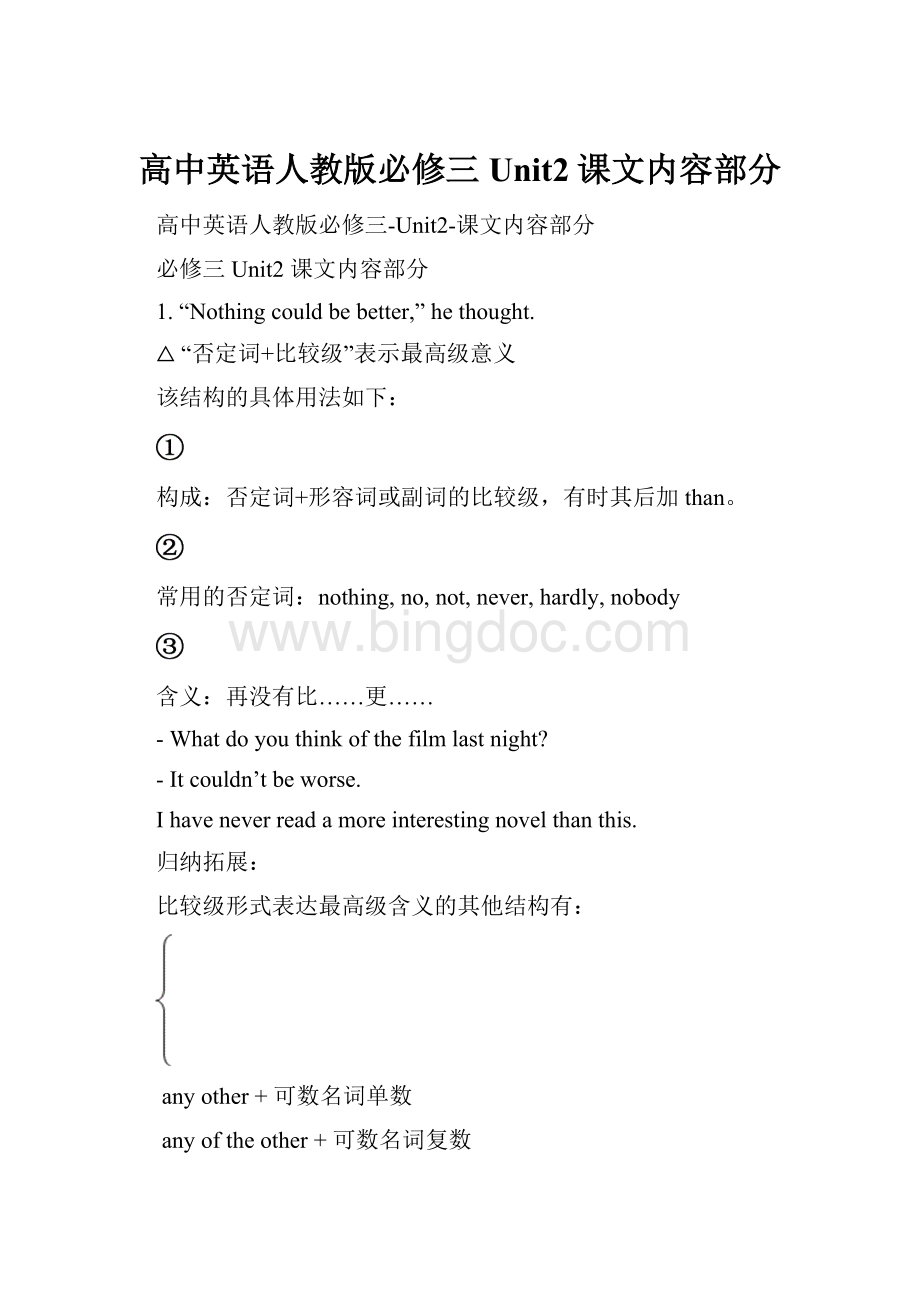高中英语人教版必修三Unit2课文内容部分.docx
《高中英语人教版必修三Unit2课文内容部分.docx》由会员分享,可在线阅读,更多相关《高中英语人教版必修三Unit2课文内容部分.docx(13页珍藏版)》请在冰点文库上搜索。

高中英语人教版必修三Unit2课文内容部分
高中英语人教版必修三-Unit2-课文内容部分
必修三Unit2课文内容部分
1.“Nothingcouldbebetter,”hethought.
△“否定词+比较级”表示最高级意义
该结构的具体用法如下:
构成:
否定词+形容词或副词的比较级,有时其后加than。
常用的否定词:
nothing,no,not,never,hardly,nobody
含义:
再没有比……更……
-Whatdoyouthinkofthefilmlastnight?
-Itcouldn’tbeworse.
Ihaveneverreadamoreinterestingnovelthanthis.
归纳拓展:
比较级形式表达最高级含义的其他结构有:
anyother+可数名词单数
anyoftheother+可数名词复数
anyoftheothers
比较级+thananyone/anythingelse
alltheother+可数名词复数
alltheothers
Tomismoreintelligentthananyotherstudent/alltheotherstudentsinhisclass.
LiYangstudiesharderthananyoneelseinhisclass.
练习:
用括号内词的适当形式填空
Ihaveneverseena______(good)filmbefore.
Theweathercouldn’tbe______(bad),sowewillnotgoout.
一句多译
他比班上其他任何男孩都高。
________________________________________________________________
________________________________________________________________
________________________________________________________________
________________________________________________________________
2.Eventhoughhercustomersmightgetthinaftereating.YongHui’sfood,theywerenoteatingenoughenergy-givingfoodtokeepthemfit.
本句为复合句,Eventhough引导让步状语从句,在主句中energy-giving为“名词+现在分词”结构的复合形容词,在句中作定语修饰food。
Keepthemfit是“keep+宾语+宾补”结构,宾补由形容词fit充当。
△复合形容词的构成
英语中常见的复合形容词的构成形式:
名词+现在分词:
mouth-watering令人垂涎的;peace-loving爱好和平的
数词+名词:
first-rate第一流的;second-hand二手的
形容词/副词+现在分词:
good-looking漂亮的;hard-working工作努力的;easy-going随和的;everlasting永久的
名/形容词/副词+过去分词:
man-made人造的;ready-made现成的;well-known著名的
名词+介词+名词:
face-to-face面对面的;heart-to-heart坦诚亲切地
数词+名词+形容词:
eight-year-old八岁的
数词/形容词+名词+-ed:
three-legged三条腿的;warm-hearted热心肠的
△“keep+宾语+宾补”结构
此结构表示“使……保持……”。
该结构的常见形式有以下几种:
keep+sb./sth.+形容词/副词
Iwastootiredtokeepmyeyesopen.
keep+sb./sth.+名词
Iwanttokeepthethingasecretbetweenus.
keep+sb./sth.+介宾短语
Youshouldkeepyourhandsbehindyourbacks.
Acoldkepthiminbedforaweek.
keep+sb./sth.+现在分词(表示主动或状态的延续)
I’msorry.Ihavekeptyouwaitingoutsideforsolong.
keep+sb./sth.+过去分词(表示被动或状态的延续)
Keepyourmouthshutandyoureyesopen.
练习:
用括号内动词的适当形式填空
MichaelputupapictureofYaoMingbesidethebedtokeephimself________(remind)ofhisowndream.
Lucyhasagreatsenseofhumorandalwayskeepsherclassmates________(amuse)withherstories.
Don’tkeepthem__________(work)dayandnight.
Theyusecomputerstokeepthetraffic________(run)smoothly.
3.IwishIcouldseethingsclearlyinthedark.
本句为复合句,wish后接省略了that的宾语从句,从句表示的内容与现在事实相反,故从句使用了虚拟语气。
△wish后的从句中虚拟语气的用法
Wish后接that从句时,从句要用虚拟语气,其用法如下:
虚拟情况
从句时态
与现在事实相反
一般过去时
与过去事实相反
过去完成时
与将来事实相反
would/could/might+动词原形
IwishIwere10yearsyounger;thenIwilldowhateverIwantto.
Wewishwehadstudiedharderwhenatschool.
IwishIcouldflytothemoononeday.
归纳拓展:
Wish还可以表示“希望(做某事),想要(某事发生);祝愿”等。
wishtodosth.想要做某事
wishsb.todosth.希望某人做某事(hope没有此用法)
wishsb.sth.希望某人……;祝愿某人……
asyouwish如你所愿
Iwishtospeaktoyourparents.
Iwishherahappybirthday.
练习:
用括号内词的适当形式填空
Iwishthatyou________(give)himmytelephonenumber,butyoudid.
HowIwishI________(go)theretomorrow,butIhavetostayathome.
IwishI________(have)acarnow.
完成句子
我希望你幸福。
Iwishyou_______________________now.
如你所愿,你明天不用参加会议了。
_______________________,youneedn’tattendthemeetingtomorrow.
我们祝你新年快乐。
Wewish_______________________.
4.“Well,Idohavetorestalot,”admittedYongHui.
△“do/does/did+动词原形”结构
此结构用于强调谓语动词,即要在动词原形前加助动词do,does或did,表示“的确,确实,真的”。
这种强调结构只有一般现在时和一般过去时两种,且没有疑问和否定形式。
do/does用于一般现在时,did用于一般过去时;do用于第一、第二人称和第三人称复数,does用于第三人称单数,did用于各种人称。
Theydoworkhardatmaths.
Hedoeslikeeatingnoodles.
Hedidhaveagoodtimelastnight.
特别提醒:
在祈使句中运用“do+动词原形”形式,往往不表示命令,而表示强烈的请求,有时表达更加客气的语气。
Docomeontimenexttime.
Docomeinandsitdown.
5.“Accordingtomyresearch,neitheryourrestaurantnormineoffersabalanceddiet,”explainedWangPeng.
本句是一个简单句,句中neither...nor...“既不……也不……”,连接两个并列成分yourrestaurant和mine作主语,谓语动词offers的数与nor后的成分保持一致。
△neither...nor...结构
neither...nor...可连接两个并列成分,表示完全否定。
如果连接两个名词或代词做主语,则谓语动词的数和nor后的主语保持一致。
(就近原则)
NeitheryounorIamgoingtodoit.
如果neither...nor...连接两个句子,且放在句首,则两个句子都需要部分倒装。
NeitherdidIgotowatchthefootballmatchnordidIcareitsresult.
归纳拓展:
连接并列的名词或代词做主语,谓语动词的数遵循就近原则的连词还有:
either...or...要么……要么……
notonly...but(also)...不仅……而且……
not...but...不是……而是……
or...或……等
NotyoubutIamtoblameforthemistakes.
练习:
语法填空
Nottheteacherbutthestudents________(be)lookingforwardtoseeingthefilm.
NotonlyhebutalsoI________(like)playingfootball.
Neitherhisparentsnorhe________(know)anythingaboutit.
Eitheryouoroneofyourstudents________(be)toattendthemeetingtomorrow.
情态动词
1.oughtto/oughtnotto
oughtto“应当,应该”,跟should用法基本一致,没有人称、数和时态的变化。
它可以表示:
“有责任或义务”做某事,语气比较强;
推测,意为“应该,应是”,暗含很大的可能性;
表示“建议”或“劝告”。
Weoughttostoppollutingnature.
Heoughttohavewrittentheletterbynow.
Yououghttoreadthisbook.It’sverygood.
oughtto后跟完成式,肯定句中表示“过去本应该做某事而未做”;否定句中表示“过去本不该做某事却做了”。
Yououghttohaveaskedhimearlier.
Yououghtn’ttohavetoldherthenews,butyoudid.
oughtto的否定形式为oughtnotto或oughtn’tto,其一般疑问句形式是将ought置于主语前。
Yououghtnottoplaytricksonthedisabled.
-OughtItoleavetomorrow?
-Yes,yououghtto.
oughtto用在反义疑问句中时,简短问句用“oughtn’t/shouldn’t+主语”。
Heoughttobehere,oughtn’t/shouldn’the?
辨析比较:
oughtto/should
一般来说,两者可换用,只是oughtto的语气略强。
另外,表示出于法令规则、行为准则、道德责任等客观情况而“应该”做某事时,一般用oughtto,多反映客观情况;若用should则含有个人意见,偏向强调主观看法。
Youarehisfather.Yououghttotakecareofhim.
Weshouldbepolitetoothers.
2.haveto/don’thaveto
haveto意为“必须,不得不”,侧重指客观需要,可用于不同时态。
Youhavetocleantheclassroombeforegoinghome.
don’thaveto表示“不必,没有必要”,即客观上没有必要做某事。
Youdon'thavetocomewithme.
辨析比较:
haveto/must
haveto强调客观需要,must则强调主观看法;
haveto有时态、人称和数的变化,而must只有一种形式;
二者的否定形式的意义不同:
don'thaveto表示“不必”,相当于don’tneedto,needn’t;mustn’t则表示“不允许,禁止”;
Hismotherwasillandhehadtostaytheretolookafterher.
ImustadmitIdon’tlikeher.
Youdon’thavetogothere.
Youmustn’tgothere.
真题链接:
You________buyagift,butyoucanifyouwantto.
A.mustB.mustn’tC.havetoD.don’thaveto
Thenewlawstatesthatpeople________driveafterdrinkingalcohol.
A.wouldn’tB.needn’tC.won’tD.mustn’t
3.need/needn’t
need作情态动词时,后跟动词原形,表示“需要,有必要”,无时态,人称和数的变化,常用于否定句、疑问句中,也可用于条件句中。
Youneedn’ttellhimaboutthematterthisafternoon.
Needwebuyanynewequipment?
IwonderwhetherIneedadvisehim.
归纳拓展:
need还可作为行为动词使用,此时有人称、时态和数的变化,后接带to的动词不定式,常见的结构有:
sb.needstodosth.某人需要做某事
Ineedtogetupearlytomorrow.
Youdon’tneedtoleaveatonce.
sth.needsdoing/tobedone某事/某物需要被……。
其中doing用主动形式表示被动意义,sth.是do所表示动作的承受者。
Mybikeneesmending/tobemended.
needn’thavedone表示“本来不必做某事却做了”。
Youneedn’thavetoldmethetruth.
由need引出的一般疑问句的肯定回答常用must或haveto,而否定回答则常用needn’t或don’thaveto.
-NeedIgonow?
-Yes,youmust./No,youneedn’t.
归纳拓展:
由must提问的一般疑问句,肯定回答用must,否定回答用needn’t或don'thaveto。
-MustIdotheworknow?
-Yes,youmust./No,youneed’t/don’thaveto.
真题链接:
I________haveworriedbeforeIcametothenewschool,formyclassmateshereareveryfriendlytome.
A.mightn’tB.mustn’tC.needn’tD.couldn’t
I’veorderedsomepizza,sowe________worryaboutcookingwhenwegethometired.
A.can’tB.darenotC.needn’tD.maynot